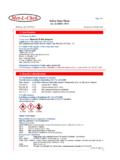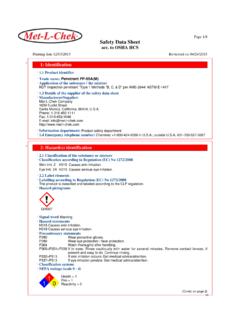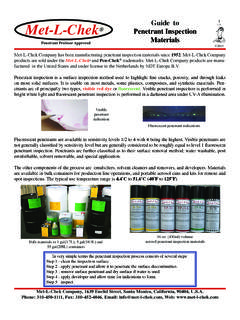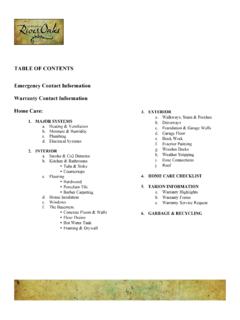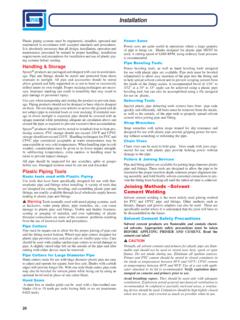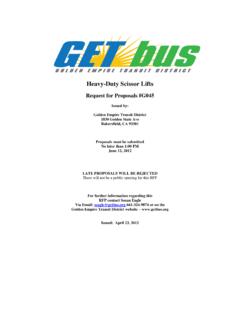Transcription of General Guide to Pre and Post Penetrant Inspection …
1 Met-L-Chek Met-L-Chek Company, 1639 Euclid Street, Santa Monica, CA 90404 Phone: (310) 450-1111 Fax: (310) 452-4046 E-Mail: PROFESSOR APPROVED 2004 For Over 50 years; One History, One Mission,Maximum Value!UltrasonicVapor DegreaseAqueousDrySteamPenetrant Process Methods for cleaning a surface to be Penetrant inspectedCleaning-1/6/04 MechanicalChemicalSolvent General Guide to Pre and Post Penetrant Inspection CleaningCleaning is an integral part of the Penetrant Inspection process. Every specification states that the part or inspectionsurface must be clean and dry. Improper cleaning is often the cause for failure of the Penetrant Inspection the Penetrant process to highlight small cracks and porosity the Penetrant must enter all discontinuities. If theseare not open then the Penetrant Inspection process will not work. There are numerous issues involved with newly manufactured components, discontinuities may be blocked by cutting fluids, coolants, mold release agentsand General dirt and grime from handling.
2 Some metal working processes will smear metal over the surface closingdiscontinuities. In overhaul and maintenance Inspection , the part surface may have grease, oil, rust, paint,carbonaceous deposits or any number of residues and soils which have been ground in as a result of use. All ofthese can prevent the Penetrant process from working by blocking entrance to a above makes it obvious that parts must be cleaned but the right cleaning must be utilized. Solvents used for vapordegreasing will remove organic soils but will not remove inorganic soils. Cleaning residues can cause failure of theinspection process. Acid and alkali residues can cause the dyes in penetrants to loose their color or will be no visible or fluorescent indication to show where the Penetrant is, even if it entered the peening with media that breaks down may force residues into a discontinuity opening. Silicates, in somecleaning compounds, may precipitate onto the part surface blocking entrance to a discontinuity.
3 After any cleaningprocess the surface must be thoroughly washed with clean water to eliminate any cleaning compound residues. Thepart will need to be thoroughly dried to prevent water from blocking Penetrant from entering a discontinuity. Partsize, geometry, material composition and environment will influence the type of cleaning that may be one or a combination of the following methods should be employed to ensure that the Inspection surfaceis clean and discontinuities are Met-L-Chek Company, 1639 Euclid Street, Santa Monica, CA 90404 Phone: (310) 450-1111 Fax: (310) 452-4046 E-Mail: PROFESSOR APPROVED 2004 For Over 50 years; One History, One Mission,Maximum Value!Steam Cleaning will remove oily soils and with the addition of an aqueous alkaline low foam cleaner, the methodis effective on stubborn greasy soils and loosely held rust and scale. This method is limited because of the temperatureand pressure employed and the part size and geometry which maybe easily handled.
4 Small parts, hollow or veinedparts are not easily cleaned in this way, whereas the weld area of large structures are ideally suited for this type ofcleaning approach. Cleaned surface must be dry and cooled to at least 125 F (52 C) before application of thepenetrant. This method will also effectively remove Penetrant Inspection residues following the Inspection STEAMSTEAM CLEANINGC onsider:TemperaturePressurePartConfigura tionMECHANICAL CLEANINGC onsider:Part DamageSmeared MetalResiduesWhen cleaning parts, consider the type of base materials that are being cleaned and the type of soils to be like materials together, do not mix materials. Segregate materials by Alloys: Aluminum or MagnesiumTitanium AlloysLow Alloy Steels: Corrodible SteelsStainless SteelsNickel/Cobalt AlloysComposite MaterialsCleaning materials must dissolve, emulsify, oxidize, wet, displace or act in some other way to assist in removingthe undesired contaminant and at the same time not attack the base component.
5 Cleaning and base component attackare often directly related to the concentration of the cleaning material, contact time with the cleaning material, thetemperature at which the cleaning takes place, and the form of agitation Cleaning is generally not recommended for light alloys which are easily smeared, closingdiscontinuities. This may happen on harder alloys as well and in such cases a chemical etch is required to removea small amount of the surface material opening any discontinuities. Mixing base metals can result in embeddingtraces of dissimilar metals in each other creating sites for corrosion and initiating flaw development. Part surfaceswhich have been mechanically cleaned will need to be further cleaned with another method to ensure all cleaningresidues are General Guide to Pre and Post Penetrant Inspection CleaningMet-L-Chek Met-L-Chek Company, 1639 Euclid Street, Santa Monica, CA 90404 Phone: (310) 450-1111 Fax: (310) 452-4046 E-Mail: PROFESSOR APPROVED 2004 For Over 50 years; One History, One Mission,Maximum Value!
6 SOLUTIONHigh Fequency TransducerULTRASONIC CLEANINGC onsider:Initial CostAdditivesDisposalUltrasonic Cleaning is a very effective method of cleaning small to medium size parts of geometrically challengedconfigurations. The addition of aqueous alkaline cleaners to the bath solution increases the effectiveness of thismethod. The initial cost of high quality Ultrasonic cleaning equipment may appear prohibitive, but the quality andrate of cleaning can often make up for this. Parts should be rinsed and dried after this method before going throughthe Penetrant Inspection process. This method is not generally employed for post Inspection cleaning of parts,however, TAM panels or other Penetrant process monitoring flaw specimens should be ultrasonically cleaned toensure Penetrant process monitoring CLEANINGC onsider:AcidCausticSafetyConcentrationTe mperatureDisposalChemical Cleaning is often employed to remove carbonaceous deposits, heat scale, protective coatings, and heavygreasy soils.
7 This type of cleaning utilizes strong acids and oxidizing agents. The use of high concentrations and orelevated temperatures will increase attack rates on the soil but the base material may also be more readily increase useful tank life of these materials, lighter soils must first be removed, often with an aqueous alkalinecleaner. Great care is required in bath make up and operation to protect not only the parts but the operators from thestrong chemistry. Disposal of the spent cleaning bath can be quite complicated and costly. Neutralization of thechemicals and thorough rinsing with clean water followed by drying is key to avoiding residue interference with thepenetrant TANKRINSEDRY General Guide to Pre and Post Penetrant Inspection CleaningMet-L-Chek Met-L-Chek Company, 1639 Euclid Street, Santa Monica, CA 90404 Phone: (310) 450-1111 Fax: (310) 452-4046 E-Mail: PROFESSOR APPROVED 2004 For Over 50 years; One History, One Mission,Maximum Value!
8 Aqueous Cleaners are widely used for both pre and post Penetrant Inspection cleaning. They are employed incabinet spray washers, agitated soak tanks, steam cleaners, ultrasonic cleaners and manual wipe applications. Mostaqueous cleaners are slightly alkaline and contain surfactants for effective wetting and removal of oily soils, looselyheld particulates, and films. The most effective aqueous cleaners are a balance of additives that clean off the soilswhile inhibiting base material attack and are environmentally more friendly than the strong chemical cleaners. Inspray systems they are used at lower concentrations than in dip or tank applications. Temperatures to 160 F (71 C)often are recommended to accelerate their cleaning action, although most will work at ambient temperatures withan increase in contact time. Aqueous alkaline cleaners are often used prior to more aggressive chemical cleaners. This is done to reduce the soil loading of the chemical cleaner tanks.
9 Aqueous cleaners have been effectively usedto replace vapor degreasing and solvent CoilVAPOR ZONESOLVENTH eaterVapor degreasing and solvent cleaning have been used for years in the metal working industries. Halogenatedhydrocarbon solvents were the choice because of their nonflammable characteristics, however, these materials havebeen found to be carcinogenic or Ozone depleting substances and are now widely banned. Flammable solvents maybe used in specially designed vapor degreasers and find wide use as wipe solvent cleaners. Flammability, healthconcerns, and their contribution to high levels limits their overall use. Solvents are effective at removing oily,resinous organic residues, but are ineffective at removing inorganic materials. This was often not understood byusers of vapor degreasers for post Penetrant Inspection cleaning; Penetrant would be removed but not the ventilation must be used wherever solvents are used, whether in large surface wipe cleaning or simplepenetrant indication wipe off and DEGREASE & SOLVENT CLEANINGC onsider:VOC'sFlammabilityNon-flammable:O LDSC arcinogensInorganic SoilsAQUEOUS CLEANINGC onsider:TimeTemperatureConcentrationDisp osal General Guide to Pre and Post Penetrant Inspection Cleaning
